*This page may include affiliate links, which means that if you make a purchase through one of the product links, we may receive a small commission. For full affiliate disclosure please see our disclaimer page.
Hello, dear readers and fellow canine enthusiasts! When it comes to our furry companions, we often consider their nutrition, exercise, and overall health. Yet, one aspect that tends to fly under the radar is the growth of their nails. “How fast do dog nails grow?” is a question that many dog owners ponder, especially when it feels like they’ve just trimmed those claws, only to find them tapping on the floor again shortly after. Nail care is more than just an aesthetic concern; it’s about comfort and health. With this guide, “How Fast Do Dog Nails Grow- Nail Length Growing Guide,” we aim to provide you with a comprehensive understanding of your dog’s nail growth rate, factors that influence it, and tips to maintain them properly. Journey with us as we delve into the intricacies of your pooch’s paws and ensure they’re always in tip-top shape! 🐾

How Fast Do Dog Nails Grow?
The speed at which dog nails grow can vary based on the breed, age, activity level, and other factors. Here’s a general breakdown:
| Factor | Description |
|---|---|
| Age | Puppies: Faster growth |
| Adult Dogs: Slower, steady growth | |
| Breed Variations | Small Breeds: Faster nail growth |
| Medium Breeds: Moderate nail growth | |
| Large Breeds: Slower growth, but thicker nails | |
| Activity Level | Active Dogs: Nails wear down, seeming slower growth |
| Less Active Dogs: Prominent nail growth | |
| Health & Nutrition | Well-fed: Steady and healthy nail growth |
| Malnourished: Slower or brittle nail growth | |
| Environmental Factors | Hard Surfaces: Natural nail filing during walks |
| Soft Surfaces: Less wear, leading to noticeable growth |
Tips for Healthy Dog Nails:
- Regularly check your dog’s nails, ideally every 1-2 weeks.
- Use the right tools for nail trimming to ensure a smooth cut.
- Pay attention to the quick of the nail to avoid injuries.
- If unsure about nail trimming, consult with a veterinarian or professional groomer.
What Happens If You Don’t Cut Dogs Nails?
1. Overgrowth and Discomfort
When a dog’s nails become too long, they can cause discomfort or even pain. As the nails grow, they can force the toes to spread apart unnaturally or cause the nails to twist to the side, leading to discomfort when walking.
2. Injury and Breaks
Long nails are more susceptible to splitting, cracking, or breaking. If a nail breaks, it can be very painful for the dog and may even bleed. In severe cases, broken nails can lead to infections if not treated promptly.
3. Altered Gait and Posture
A dog’s posture and gait can be negatively affected by long nails. When nails touch the ground as the dog walks, it exerts pressure back into the nail bed, creating pain or discomfort. Over time, this can lead to a change in how the dog walks, potentially causing joint strain or other orthopedic issues.
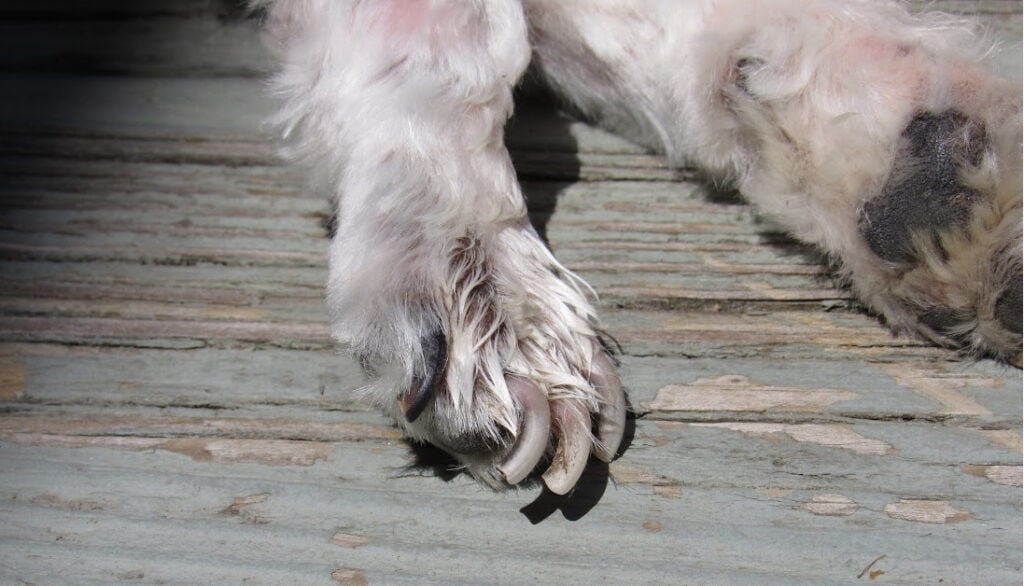
4. Reduced Traction
Long nails can reduce a dog’s ability to grip surfaces, particularly on tile or hardwood floors. This can increase the risk of slipping, which could lead to injuries.
5. Ingrown Nails
Just like humans, dogs can also suffer from ingrown nails. This happens when the nail grows back into the paw pad. Ingrown nails are painful, can become infected, and often require veterinary intervention.
6. Reduced Socialization
If a dog associates its long, painful nails with certain activities like walking or playing, it might become hesitant or resistant to participate. This can lead to reduced socialization and activity, affecting their overall well-being and mental health.
Regular nail trims are essential for maintaining your dog’s health and comfort. Not only does it prevent potential physical complications, but it also ensures your furry friend remains active and happy. Always keep an eye on the length of your dog’s nails and trim them regularly, either at home or with the help of a professional groomer.
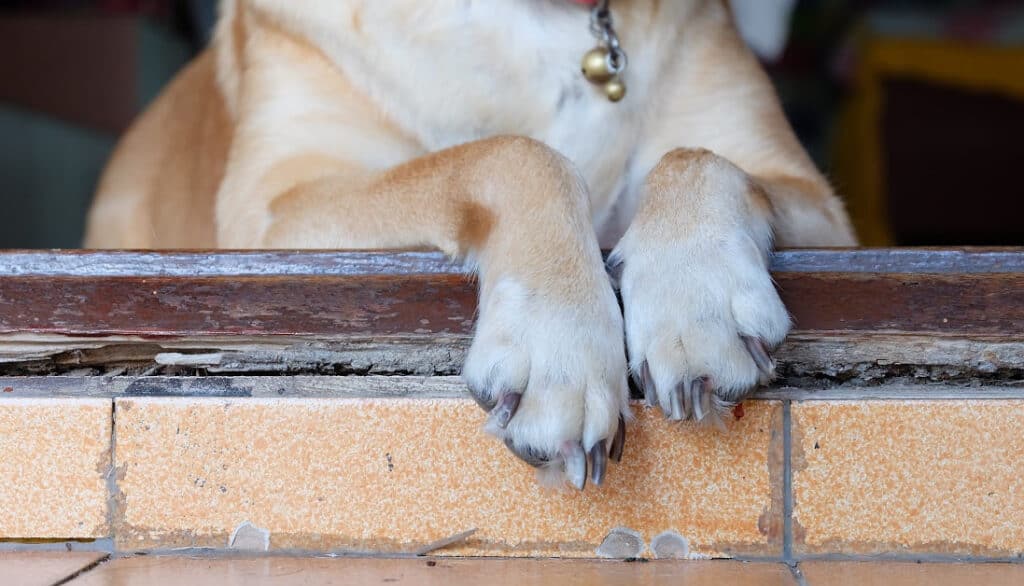
Tips for Shortening Nails
Ensuring that your dog’s nails are kept at a healthy length is crucial for their overall well-being. Here are some effective tips to help you maintain or reduce their nail length:
1. Regular Trimming
The simplest and most direct way to keep nails short is by trimming them regularly. Depending on how fast your dog’s nails grow, you might need to do this every two to four weeks.
2. Use the Right Tools
Invest in a good quality pair of dog nail clippers. There are different types, such as guillotine-style or scissor-style clippers. Some dog owners also prefer using a rotary tool or nail grinder, which files down the nails.
3. Start Young
If you have a puppy, start the nail trimming routine early. Puppies who get used to having their feet handled and nails trimmed at a young age are usually more accepting of the process as adults.

4. Gradual Reduction for Overgrown Nails
If nails are extremely overgrown, don’t try to cut them short all at once. Instead, trim a little bit off at a time over several weeks to allow the quick (the sensitive part of the nail) to recede naturally.
5. Positive Reinforcement
Reward your dog with treats and praise during and after nail trimming. This can help make the experience more positive for them, making future trims easier.
6. Familiarize Yourself with the Quick
The “quick” is the blood vessel that runs through the nail. Cutting into it can cause pain and bleeding. In light-colored nails, the quick is the pinkish section. For dogs with dark nails, it’s harder to see, so only trim a small amount at a time or use a flashlight behind the nail to help locate it.
7. Frequent Walks on Pavement
Walking your dog regularly on pavement or concrete can help naturally file down their nails. However, be cautious during hot weather, as hot surfaces can burn a dog’s paw pads.
8. Consult with Professionals
If you’re unsure about trimming your dog’s nails yourself, consider taking your pet to a professional groomer or veterinarian. They can give you a demonstration or provide tips tailored to your specific dog.
9. Stay Calm and Confident
Dogs often pick up on our emotions. If you’re nervous about cutting their nails, they’ll likely become anxious too. Taking a calm and confident approach will make the process smoother for both of you.
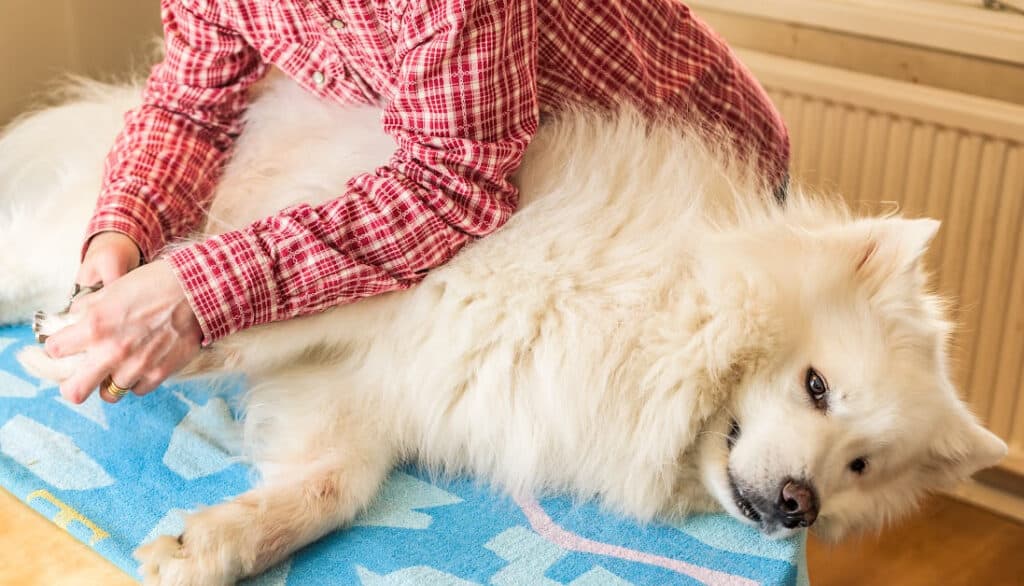
When to Trim Your Dog’s Nails
Knowing when to trim your dog’s nails is crucial for their comfort, health, and overall well-being. Let’s delve into the various indicators and best practices associated with nail trimming.
1. Clicking Sounds on Hard Surfaces
One of the most common signs that it’s time to trim your dog’s nails is when you hear them clicking or tapping as they walk on tile, hardwood, or other hard surfaces.
2. Observation
- Curvature: If the nails start to curve downwards or sideways, it’s an indication that they’re getting too long.
- Touching the Ground: When your dog is standing still, their nails shouldn’t touch the ground. If they do, it’s time for a trim.
3. Discomfort or Altered Gait
If your dog starts to walk differently, limps, or seems to be in discomfort when walking, long nails might be the cause.
4. Regular Check-ups
Even if none of the above signs are evident, it’s a good practice to check your dog’s nails:
- Puppies: Every week, as they tend to grow quickly.
- Adult Dogs: Every 2-4 weeks.
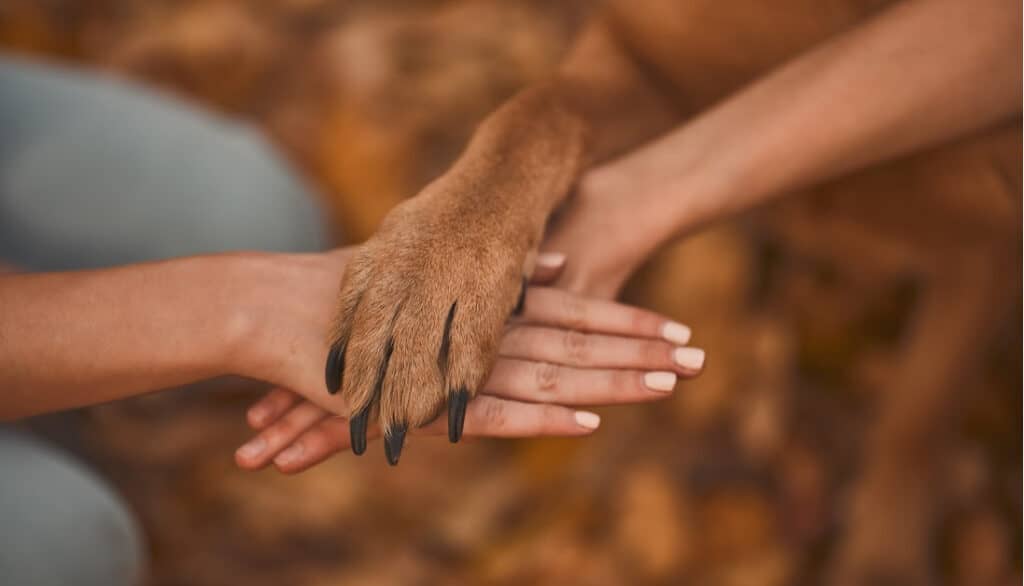
5. Post-Activity Check
After activities like playing in the mud or swimming, nails can become softer and more vulnerable to breaking. It’s a good idea to inspect and, if necessary, trim them post such activities.
6. Check the Dewclaws
The dewclaws, or the nails higher up on the paw, don’t always touch the ground and therefore don’t wear down naturally. Regularly check these, as they can grow in a circular pattern back into the paw if left unattended.
7. After Bath Time
Nails are softer after a bath, making it a good time to trim them. If you integrate nail trimming into the post-bath routine, it can become a regular habit.
8. Based on Previous Growth Rate
Every dog is unique. Some dogs may need nail trims every two weeks, while others might go a month or more. By observing and understanding your dog’s nail growth rate, you can set a more personalized trimming schedule.
Regular nail maintenance is vital for a dog’s health and comfort. By staying observant and integrating nail checks into routine care, you can ensure that your furry friend’s paws remain in tip-top shape.
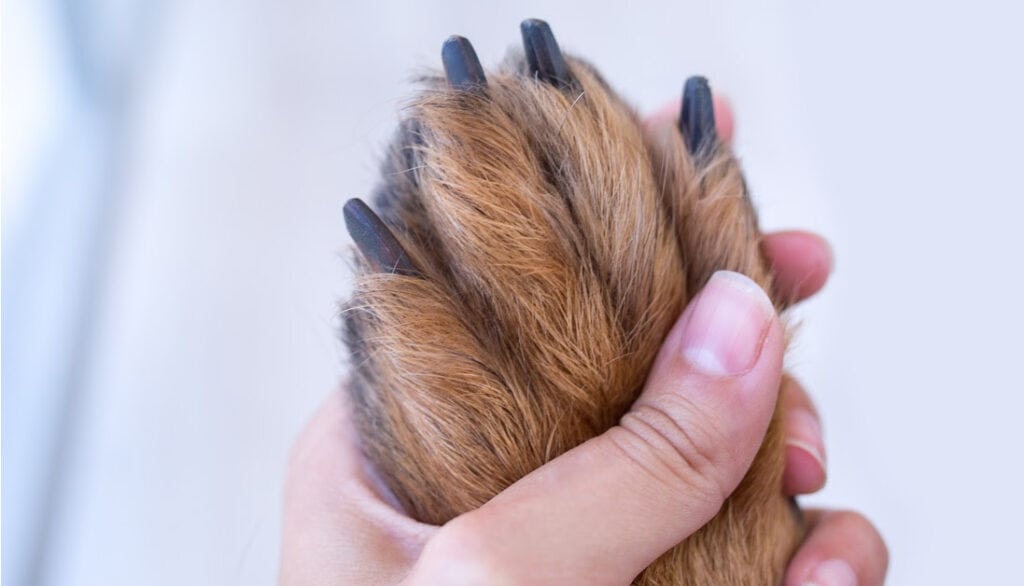
What Causes Toenail Breakage in Dogs?
Toenail breakage in dogs can be distressing for both the pet and the owner. Understanding the root causes can help in preventing such incidents and ensuring your dog remains pain-free and happy. Here are the most common causes:
1. Overgrown Nails
Long nails are more prone to snagging and getting caught on surfaces like carpets, gaps in wooden floors, or between deck planks. This can lead to sudden breaks or cracks.
2. Trauma
Running, playing, or roughhousing can sometimes lead to toenail injuries, especially if the dog stops suddenly or collides with an object. Jumping off elevated surfaces or getting a nail caught while moving can also result in trauma.
3. Brittle Nails
Some dogs naturally have brittle nails, or they may develop them due to medical conditions, age, or nutritional deficiencies. Brittle nails are more likely to split, crack, or break.
4. Infections or Fungal Diseases
Infections, especially fungal ones, can weaken the nail structure. A weak nail is more susceptible to breakage.
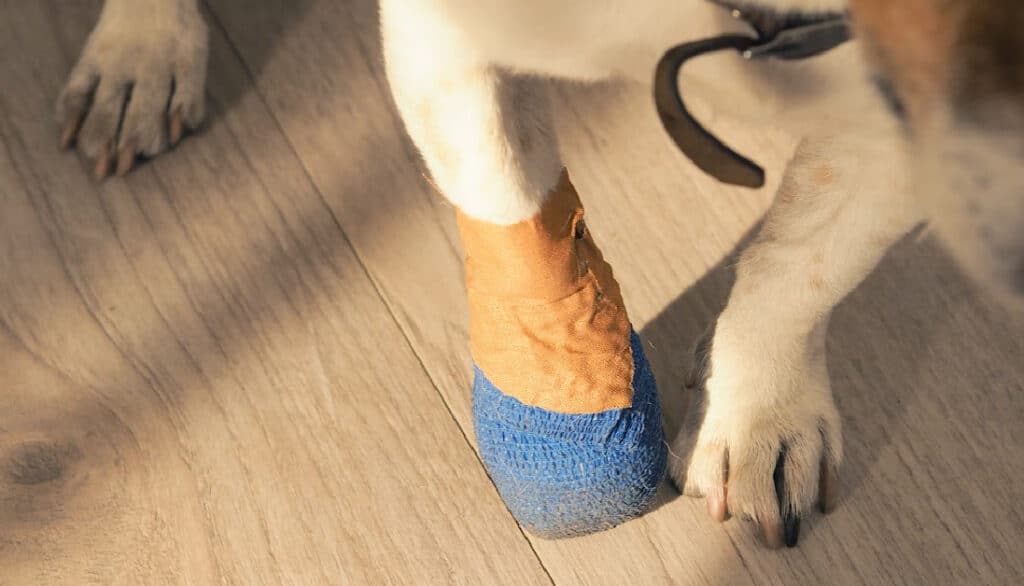
5. Tumors or Growths
In rare cases, tumors or growths on the nail bed or in the nail matrix can cause deformities and weaknesses, making breakages more likely.
6. Allergies
Dogs with allergies may excessively lick or chew their paws, weakening the nails over time and making them prone to breakages.
7. Poor Nutrition
A diet deficient in essential nutrients can lead to weaker nails. Proper nutrition, including specific vitamins and minerals, is vital for strong and healthy nails.
8. Frequent Exposure to Water
Dogs that spend a lot of time swimming or in wet environments might experience softer nails, which can be more prone to tearing or breaking.
9. Genetic Predisposition
Some dog breeds or individual dogs may be genetically predisposed to have weaker or more brittle nails, leading to more frequent breaks.
Toenail breakage in dogs can result from a combination of environmental, genetic, and health factors. It’s essential to keep an eye on the condition of your dog’s nails and provide the necessary care, nutrition, and preventive measures to minimize the risk of breakage. If you notice frequent breakages or any signs of infection, it’s wise to consult a veterinarian.

Conclusion
Our dogs rely on us for more than just food and love; they need us to ensure their overall well-being, and a significant part of that is nail care. While seemingly a small detail in the grand scheme of pet ownership, the health and length of a dog’s nails can greatly impact their comfort, mobility, and overall quality of life. By understanding the intricacies of nail growth, the repercussions of neglect, and the potential causes of nail issues, you’re better equipped to provide the best care possible for your furry friend. Regular nail maintenance might require a bit of time and patience, but the rewards—a happy, healthy, and sprightly companion—are well worth the effort. After all, every small act of care we show contributes to a lifetime of happiness for our loyal pals. So, grab those clippers, offer a comforting pat, and take a step toward ensuring your dog’s paws are always in top-notch condition!
Frequently Asked Questions
The frequency varies depending on the breed, age, activity level, and individual growth rate of the dog. However, a general guideline is every 2-4 weeks for adult dogs and weekly for puppies.
If you accidentally cut into the quick, don’t panic. It will bleed and may be painful for the dog. Apply styptic powder or cornstarch to the bleeding nail to help stop the bleeding. Comfort your dog and ensure they’re calm before proceeding or deciding to continue another day.
While walking or running on hard surfaces can naturally file down a dog’s nails, it may not be sufficient for all nails, especially the dewclaws. Regular checks and trims are still necessary to ensure all nails are at a healthy length.
Start with positive reinforcement, rewarding your dog for calm behavior during nail checks. You can also desensitize them by handling their paws regularly without trimming. If anxiety persists, consider seeking the help of a professional groomer or veterinarian, or try anti-anxiety aids and tools.
While all dogs can experience nail issues, some breeds with certain genetic predispositions, like the Dachshund, might have more nail-related problems. It’s essential to be aware of your breed’s specific health concerns and monitor their nails closely.
